Mk III helmet
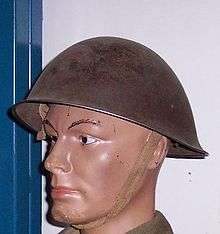
The Mk III Helmet was a steel military combat helmet first developed for the British Army in 1941 by the Medical Research Council. First worn in combat by British and Canadian troops on D-Day, the Mk III and Mk IV was used alongside the Brodie helmet for the remainder of the Second World War. It is sometimes referred to as the "turtle" helmet by collectors, because of its vague resemblance to a turtle shell, as well as the 1944 pattern helmet.
Design
The Mark III helmet was designed to provide better protection for the side of the head than its predecessor. It was a deeper helmet with a smaller brim and provided 38% more protection than the Mark II, particularly at the sides (total area of head protection was increased by 12%, horizontal protection was increased by 15% and from items falling from overhead by 11%). The Mark III helmet was issued primarily to assault troops for the Normandy invasion in June 1944, and a large number of helmets from British stocks were issued to the 3rd Canadian Infantry Division in addition to British units. Small numbers also went to the 2nd and 4th Canadian Divisions. All Mark III helmets in Canadian stores were returned to the UK shortly after the end of World War II.
The Mk III gradually replaced the Brodie helmet from 1944 onwards. The Mk III was itself replaced after the war by the Mark IV helmet, which it closely resembled. The differences were that the rivets attaching the chinstrap to the helmet were placed much lower down on the shell and the use of a "lift-the-dot" fastener for the liner. These modifications allowed the Mk IV to be utilised for carrying water. In 1959 a new, more padded, liner was introduced into service but the steel helmet body was unchanged. Hence, the title of the helmet (at least in British army stores catalogues) remained the MK IV. In 1985 the nylon fibre Mark 6 helmet was introduced into service to replace the MK IV, although it was some years before the issue was universal.
Production
Although designed in 1941, due to production issues, the helmet was not manufactured until late 1943. It was produced by three manufacturers in the UK:
| Code | Maker | Location |
| BMB | Briggs Motor Bodies Ltd | Dagenham |
| JF&L | Fisher & Ludlow Ltd | Castle Bromwich |
| ROCO | Rubery Owen Co. Ltd | Leeds |
Helmet manufacture commenced in November 1943 until early 1945 when production shifted to the MK IV helmets.[1] Mk III helmets were initially painted with textured khaki green colour, later replaced by a textured dark brown.
Mk III helmets were fitted with the same helmet liner as used in the Mk II helmet. There is some evidence that Mk III helmets were supplied to infantry units without a liner. The new owner was to simply remove their previous liner (and therefore the right size liner) from their Mk II and fit in the Mk III.
Post-war refurbished helmets
It is possible to find a war-time dated Mk III that was later fitted with the 'lift the dot' liner. These refurbishments generally took place in the 1950s. Mk III helmets were also used by British soldiers during the Korean War.
Gallery
 Training with a Lifebuoy flamethrower in Hampshire, 29 April 1944
Training with a Lifebuoy flamethrower in Hampshire, 29 April 1944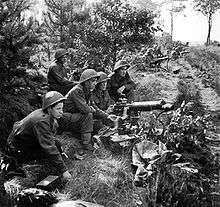 British Vickers machine gunners wearing the Mk III helmet in combat in the Netherlands on 20 September 1944, during Operation Market Garden
British Vickers machine gunners wearing the Mk III helmet in combat in the Netherlands on 20 September 1944, during Operation Market Garden Royal Canadian Navy Beach Commando "W" landing on Juno Beach, Mike sector of the Normandy beachhead – 6 June 1944. Most are wearing Mk III helmets
Royal Canadian Navy Beach Commando "W" landing on Juno Beach, Mike sector of the Normandy beachhead – 6 June 1944. Most are wearing Mk III helmets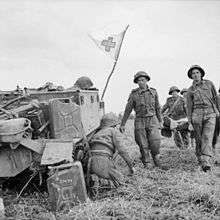 Casualty evacuation during Operation Epsom on 27 June 1944
Casualty evacuation during Operation Epsom on 27 June 1944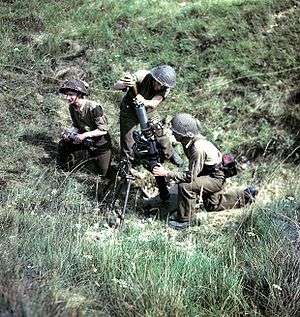 Rare colour photo of a Canadian mortar team, taken in 1944. All three men are wearing Mk III helmets.
Rare colour photo of a Canadian mortar team, taken in 1944. All three men are wearing Mk III helmets. Rare colour photo of Bofors 40 mm gun crew in Normandy, 1944. All four men are wearing Mk III helmets.
Rare colour photo of Bofors 40 mm gun crew in Normandy, 1944. All four men are wearing Mk III helmets.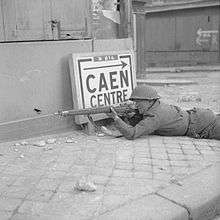 Canadian soldier wearing Mk III helmet in Caen, 9 July 1944.
Canadian soldier wearing Mk III helmet in Caen, 9 July 1944.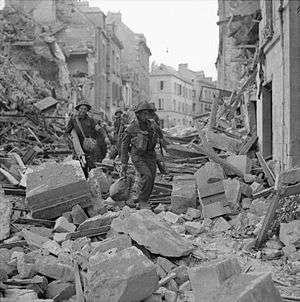 Troops pick their way through the rubble of Caen, 9 July 1944.
Troops pick their way through the rubble of Caen, 9 July 1944. British troops firing a captured Hotchkiss M1914 machine gun during street fighting in Caen, 10 July 1944.
British troops firing a captured Hotchkiss M1914 machine gun during street fighting in Caen, 10 July 1944.
References
- ↑ "Steel Helmet, MKIII (with net): British". Imperial War Museum. Retrieved 30 December 2014.
| Wikimedia Commons has media related to Mk III Helmet. |